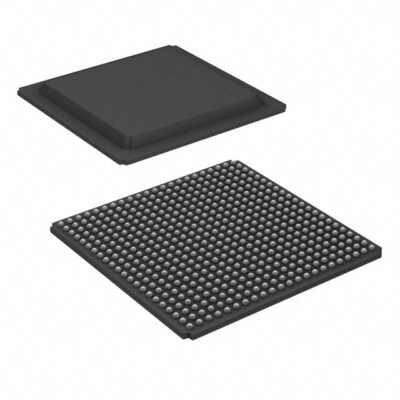XC6SLX45T-3FGG484I
Part Number: XC6SLX45T-3FGG484I
Manufacturer: AMD
Description: IC FPGA 296 I/O 484FBGA
Shipped from: Shenzhen/HK Warehouse
Stock Available: Check with us
ICRFQ.com - Electronic Components Distributor in China Since 2003

Part Number: XC6SLX45T-3FGG484I
Manufacturer: AMD
Description: IC FPGA 296 I/O 484FBGA
Shipped from: Shenzhen/HK Warehouse
Stock Available: Check with us
| Datasheet | |
|---|---|
| Category | Integrated Circuits (ICs) |
| Family | Embedded – FPGAs (Field Programmable Gate Array) |
| Manufacturer | Xilinx Inc. |
| Series | Spartan? 6 LXT |
| Part Status | Active |
| Number of LABs/CLBs | 3411 |
| Number of Logic Elements/Cells | 43661 |
| Total RAM Bits | 2138112 |
| Number of I/O | 296 |
| Number of Gates | – |
| Voltage – Supply | 1.14 V ~ 1.26 V |
| Mounting Type | Surface Mount |
| Operating Temperature | -40°C ~ 100°C (TJ) |
| Package / Case | 484-BBGA |
| Supplier Device Package | 484-FBGA (23×23) |
| Online Catalog | Spartan?-6 LXT |
FPGAs (Field-Programmable Gate Arrays), which provide unequaled flexibility and performance, have become a crucial component of contemporary electrical architecture. The XC6SLX45T-3FGG484I, a powerful and adaptable Spartan-6 device, stands out among the many FPGA alternatives available. The XC6SLX45T-3FGG484I FPGA’s salient features, performance traits, operating temperature ranges, and prospective applications will all be covered in detail in this extensive manual.
Xilinx’s Spartan-6 FPGA series is famous for its outstanding performance and dependability. It offers a wide variety of devices made to fit different applications in the commercial, industrial, automotive, and defense sectors. A notable member of this family that combines cutting-edge technology with exceptional efficiency is the XC6SLX45T-3FGG484I.
The XC6SLX45T-3FGG484I FPGA is an appealing option for designers thanks to its numerous amazing features. It makes use of the Spartan-6 design, which features high-performance logic cells, lots of block RAM, and fast I/O capabilities. For the best performance, use a speed grade of -3, which is perfect for computationally demanding tasks.
The appropriateness of an FPGA for a given environment is greatly influenced by temperature ranges. The XC6SLX45T-3FGG484I supports commercial (C), industrial (I), and extended (Q) temperature ranges to accommodate a wide range of applications. It also provides variants for the automotive and defense industries, with specifications that are comparable to those of their commercial counterparts, save where stated.
One noteworthy feature is that the MCB (Memory Controller Block) capability is not supported by the -3N speed grade. This constraint must be taken into account while selecting the suitable FPGA type for projects requiring extensive memory interfaces.
The best speed grade must be chosen in the Spartan-6 FPGA family in order to maximize system performance. The effects of various speed grades will be discussed, and the benefits of the -3 speed grade for the XC6SLX45T-3FGG484I will be examined in depth.
Electrical DC (Direct Current) and AC (Alternating Current) parameters play a critical role in determining how well an FPGA like the XC6SLX45T-3FGG484I performs. Designers who are aware of these characteristics can make sure that the FPGA performs efficiently and dependably in their particular applications. Why these parameters are important is as follows:
The steady-state characteristics of the FPGA, such as voltage levels, current usage, and static power dissipation, are referred to as DC parameters. These variables affect the FPGA’s overall dependability, heat dissipation, and power efficiency. Designers can manage heat concerns, optimize power usage, and ensure appropriate functionality by looking at DC parameters.
AC parameters, such as setup and hold times, maximum operating frequencies, and signal propagation delays, are related to the FPGA’s dynamic behavior. The speed and effectiveness of the FPGA are directly impacted by these characteristics. To meet timing requirements, prevent setup and hold violations, and achieve the desired system performance, it is essential to analyze AC parameters.
The XC6SLX45T-3FGG484I FPGA’s timing characteristics offer information on how it reacts to input signals and how rapidly it generates output results. Several crucial aspects of timing include:
The design process and circuit optimization are substantially impacted by understanding the temporal characteristics of the FPGA:
Successful design implementation requires a detailed understanding of the DC and AC electrical parameters as well as the timing properties of the XC6SLX45T-3FGG484I FPGA. Using this information, designers may produce high-performance, dependable FPGA-based systems by optimizing their circuits and making informed judgments.
For effective project planning, it is essential to comprehend the XC6SLX45T-3FGG484I’s suitability for various temperature ranges and speed grades. In this section, we’ll talk about the usual modifications that are offered for automotive, defense-grade, commercial, and industrial applications.
The XC6SLX45T-3FGG484I Spartan-6 FPGA, a true marvel of high performance, temperature versatility, and unmatched dependability, will show you the power of innovation. Engineers can use this exceptional equipment to the fullest extent possible in their projects because it is the best option for a wide range of applications. Take advantage of the chance to advance your projects. Order from ICRFQ, the top distributor of electronic components in China, right away. Get in touch with us right away to embrace innovation and discover the XC6SLX45T-3FGG484I’s amazing qualities for yourself. Your future in innovative electronic designs is here!
WhatsApp us